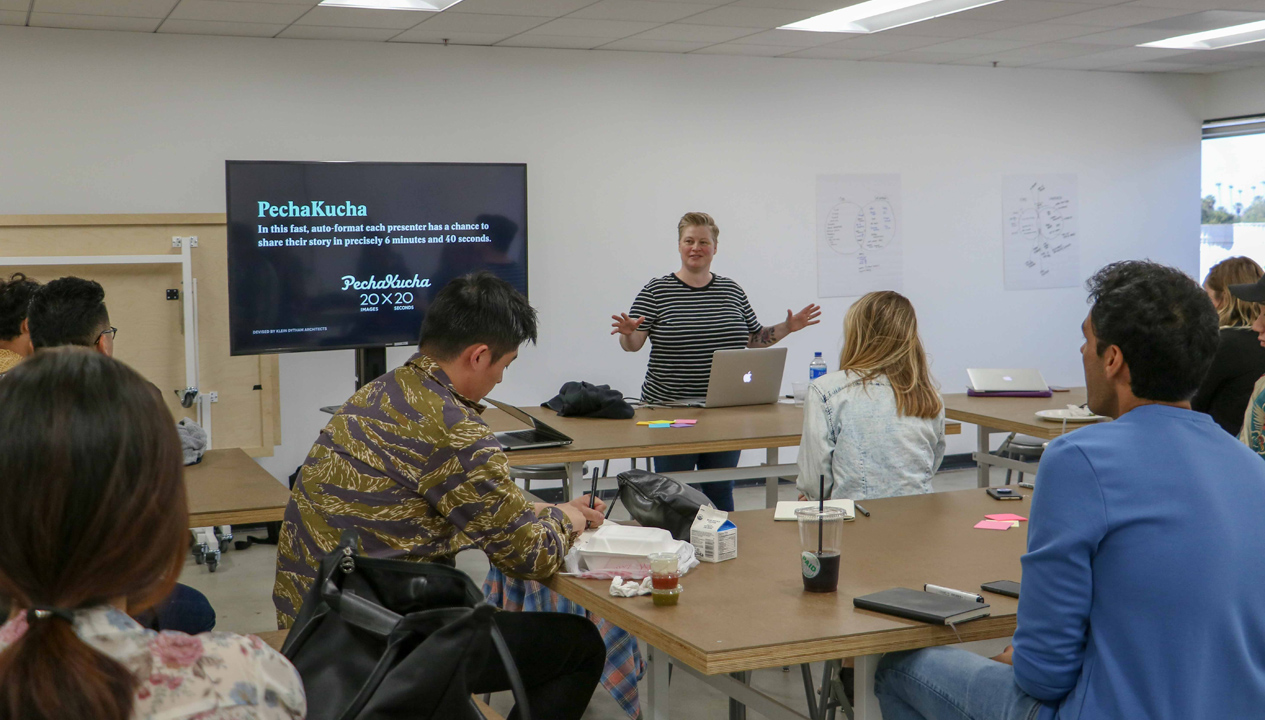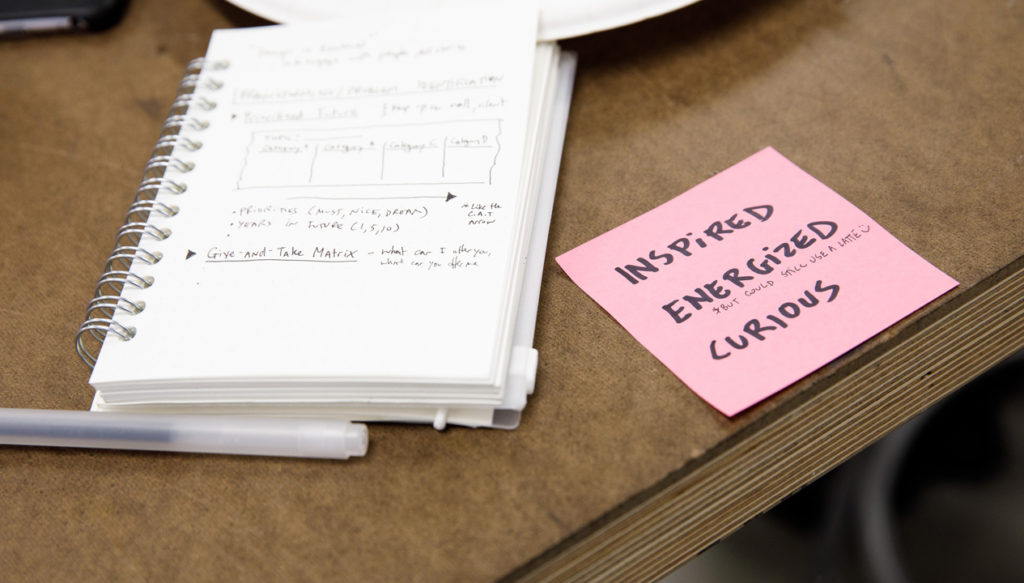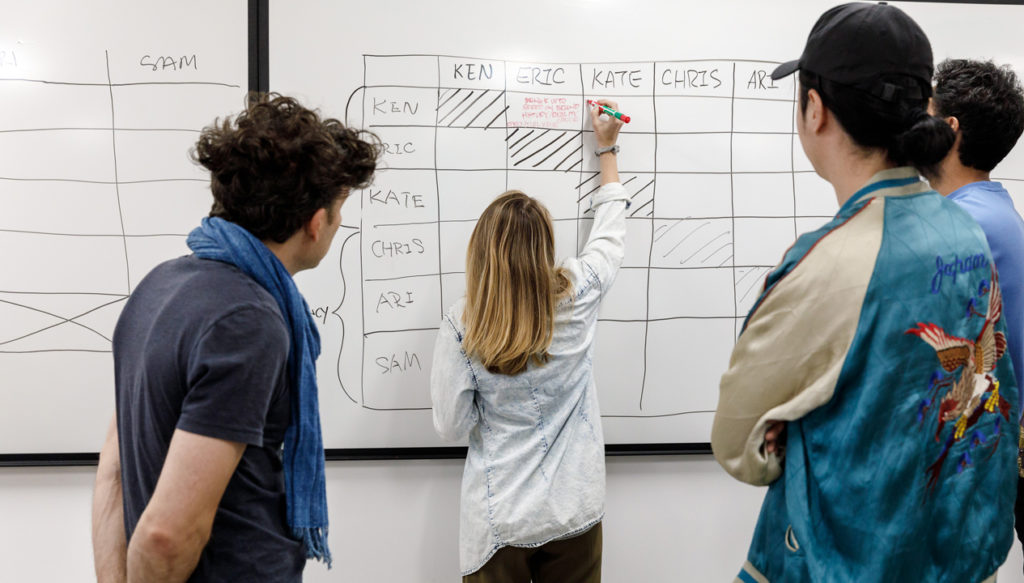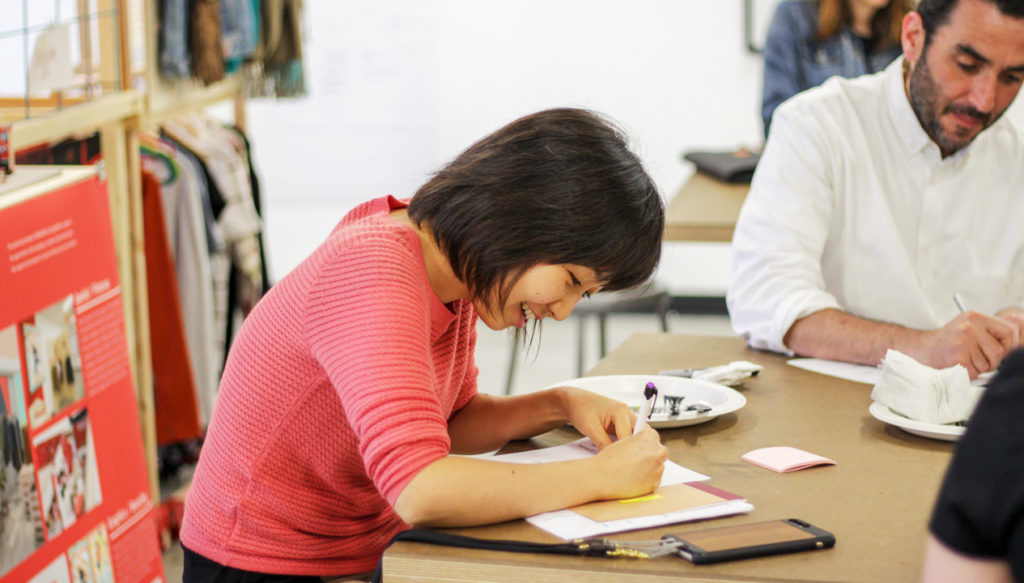After I read the email from Designmatters for Dawn Hancock’s A Workshop About Workshops, I immediately RSVP’d as my eyes latched onto the words “strategies,” “workshops,” “co-creation exercises” and “uncovering questions.” I had learned from my design education that communication and asking the right questions are key to understanding and uncovering the needs, objectives, and goals of the project or idea you (and your collaborators) are realizing. If I could learn more about the tools and strategies that would encourage both, I was in!
The Workshop
Within a span of three hours, Dawn Hancock shared various exercises to teach us the workshopping skills she uses while working with her team and clients. We were encouraged to learn not only by listening to what she had to say, but by engaging in various hands-on exercises and being encouraged to ask lots of questions along the way. The exercises were broken down into three segments: Intros / IceBreakers, Brainstorming / Problem Identification, and Closing / Wrap Up.
Part One: Intros / IceBreakers,
Pie Chart Agenda
Same / Different
PechaKucha
In 3 Words
For one of the Intros / IceBreakers exercises, we were asked to pair with someone we didn’t know. We were a diverse mix of educators, parents, alumni, and graduate and undergraduate students from various design disciplines, including; Environment Design, Product Design, and Graphic Design. As we looked across the room, locking uncertain eyes at the beginning of the exercise, we all quickly became more comfortable and familiar with each other after doing an exercise of Same / Different. This exercise uses the familiar Venn diagram model to organize and visualize the similar and different attributes we share in relation to our partners. For example, if I liked ice cream, and (gasp!) my partner didn’t, this difference would be written on opposite bubbles of the Venn Diagram. The fact that we both liked (yay!) collaging would be written in the middle where the two bubbles intersect.
In order to have this informational and insightful diagram occur, I also realized that the Same / Different exercise asks for collaboration early on—and being collaborative asks for each of us to open up and share. The more we open up and share, the more we come to share the unique quirks (my first kiss at 23), realize similarities (thinking you didn’t like animation until you realized, you also love The Simpsons), and find unexpected connections (finding out you both share a geographical tie, having spent time in South Africa despited being two individuals from different ethnic backgrounds some 40 years apart).
The workshop helped the Venn diagram feel fresh, because I came to realize that when you’re doing a Venn diagrams with people as an exercise, it’s a tool that never gets old because each person you meet is unique, and the relationship that you are building with each of them will always be new. This feeling magnified by ten once we started to go around the room, allowing each group to share what they learned about their partners. I experienced again, how effective this tool is in not only learning about the unique traits of each individual participant, but also seeing the interesting connections and similarities emerge within the whole of the group within such a short amount of time.
The Venn diagrams themselves became fun visual artifacts of the stories told and the personalities that that told them. With my partner, I realized I wrote in large, rounded, spontaneous letterforms marked with messy doodles, while my partner wrote in straight, neat lettered forms. I didn’t tell her out loud at the time, but I remember thinking, “Wow, she seems to be really organized and concise in her thinking.” Another observation I saw, was that only one group of the eight had diverged from writing within the bubble by extending lines from the bubbles to write in the white space around the Venn diagram! I marveled and chuckled a bit to myself because I realized that although we are all part of the creative field engaged in thinking outside-the-box, most of us still chose by default to conform to the convention of the bubble rather than emerge outside of it.
Part Two: Brainstorming / Problem Identification
Prioritized Future Part 1
Give-and-Take Matrix
3-12-3
Balancing Act
The Give-and-Take matrix is a chart that asks what each member can give (or offer) to the other members on the team based on their assigned roles within the team. The Give-and-Take Matrix was one of the more challenging workshopping tools we learned, as it required a larger group of 4-5 people to constantly engage with one another to define and clarify the information we were all working together as a team to fill out. For example, if I were the Design Researcher in the team, I would be asked to define and clarify what asset I would be able to give to the In-House Designer, the Agency Director, and the Strategist within my team. This process takes its cue from an improv game called “Yes, and…” The goal of this improve exercise is to build upon the previous statement of the prior participant, by affirming what was contributed by the participant with a “yes,” and building upon that statement with an “and” as opposed to a “but,” which functions to negate or contradict the prior participant’s statement. By transferring this idea to the Give-and-Take Matrix, the exercise not only helps to define and clarify your own role, but asks you and your teammates to see and acknowledge the assets each team member brings while better understanding what motivates each member. The Give-and-Take Matrix is a team building exercise that focuses on establishing a positive environment that affirms and supports each team member’s role, while ironing out possible conflicts, or “collision points,” earlier on in the project before they become tangled and messy.
Part Three: Closing / Wrap Up.
Prioritized Future Part 2
Gossip Time
Graphic Game plan
Diversity Wheel
Gossip Time, despite the negative connotation suggested by its name, is actually a positive affirmation exercise that occurs towards the end of a workshop. After spending hours or a full day with your group, you get to compliment them by sharing a positive message or attribute about each person with post-its and a pen. The concept is simple and the tools super accessible—and to include this into your repertoire of workshopping skills seems indispensable in creating a positive environment for your teammates that affirms and builds them up, such that their strengths are openly acknowledged, supported, and thanked.
The three hours went by zipping-ly fast, aided by a generous table of coffee, pastries, and fresh fruit. While we tend to focus on how workshops as a space for the tools and strategies that aid us in our journey towards information and insight—Dawn Hancock emphasized that workshops are first and foremost about the people. Workshops are not only about gathering or clarifying information, it’s about getting to know your team and clients. It’s about developing trust. And with trust, you and your team can stand on a positive foundation of healthful relationships and environment to make awesome stuff happen.
Jessica Lee (’14 Media Design Practices) is a field researcher. She uses design thinking to engage and collaborate with people.




